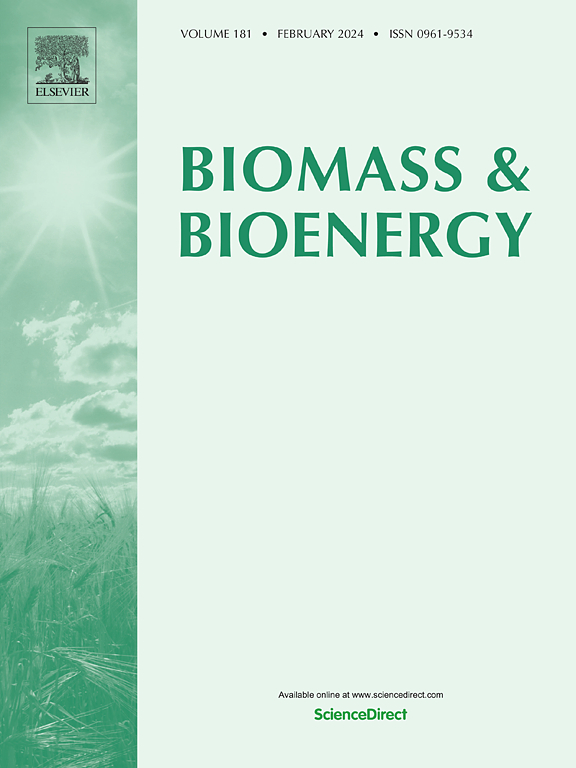优化生物柴油生产:微波和超声波酯交换与传统技术的能源效率和动力学性能
IF 5.8
2区 生物学
Q1 AGRICULTURAL ENGINEERING
引用次数: 0
摘要
这项研究探讨了通过微波和超声波辅助酯交换法提高生物柴油的生产,比较了它们与使用碳酸钾(K₂CO₃)作为成本效益高的非均相催化剂的传统方法的效率。结果表明,在最佳条件下(60 min,甲醇与油(MTO)的摩尔比为12:1,催化剂质量分数为2.5 wt%,温度为60℃,转速为300 rpm),常规酯交换反应产率为90.7%,能耗为2574 kJ。相比之下,微波辅助酯交换反应(6∶1 MTO摩尔比,1 wt%催化剂,1 min)和超声波辅助酯交换反应(6∶1 MTO摩尔比,1 wt%催化剂,15 min)分别获得了90.7%和90.3%的生物柴油产率,同时降低了97.5%和85%的能耗。结果表明,微波技术是生产生物柴油最有效的技术,操作条件最小,能耗最小,生物柴油规格最高,其次是超声波技术。将生产的生物柴油与石油柴油混合后,CO排放量从0.18%降至0.11%,HC排放量从47 ppm降至32 ppm。这项研究提供了一种简单、廉价、可行的方法,可以促进和促进生物柴油作为可再生能源的广泛生产和采用。本文章由计算机程序翻译,如有差异,请以英文原文为准。
Optimizing biodiesel production: Energy efficiency and kinetic performance of microwave and ultrasonic transesterification vs. conventional techniques
This study explores the enhancement of biodiesel production via microwave- and ultrasonic-assisted transesterification, comparing their efficiencies against conventional methods using potassium carbonate (K₂CO₃) as a cost-effective heterogeneous catalyst. The results show that conventional transesterification, under optimal conditions (60 min, 12:1 methanol-to-oil (MTO) molar ratio, 2.5 wt% catalysts at 60 °C and 300 rpm), yields 90.7 % biodiesel while consuming 2574 kJ of energy. In contrast, microwave-assisted transesterification (6:1 MTO molar ratio, 1 wt% catalyst, 1 min) and ultrasonic-assisted transesterification (6:1 MTO molar ratio, 1 wt% catalyst, 15 min) achieved 90.7 % and 90.3 % biodiesel yields, respectively, while reducing energy consumption by 97.5 % and 85 %. The results prove that the microwave is the most effective technique for biodiesel production with minimum operating conditions, energy consumption, and the highest biodiesel specifications followed by the ultrasonic technique. Blending the produced biodiesel with petrodiesel reduced the CO exhaust emission from 0.18 to 0.11 vol % and HC exhaust emission from 47 to 32 ppm. This study affords a simple, cheap, available process that can be implemented to promote and facilitate the widespread production and adoption of biodiesel as a renewable energy source.
求助全文
通过发布文献求助,成功后即可免费获取论文全文。
去求助
来源期刊

Biomass & Bioenergy
工程技术-能源与燃料
CiteScore
11.50
自引率
3.30%
发文量
258
审稿时长
60 days
期刊介绍:
Biomass & Bioenergy is an international journal publishing original research papers and short communications, review articles and case studies on biological resources, chemical and biological processes, and biomass products for new renewable sources of energy and materials.
The scope of the journal extends to the environmental, management and economic aspects of biomass and bioenergy.
Key areas covered by the journal:
• Biomass: sources, energy crop production processes, genetic improvements, composition. Please note that research on these biomass subjects must be linked directly to bioenergy generation.
• Biological Residues: residues/rests from agricultural production, forestry and plantations (palm, sugar etc), processing industries, and municipal sources (MSW). Papers on the use of biomass residues through innovative processes/technological novelty and/or consideration of feedstock/system sustainability (or unsustainability) are welcomed. However waste treatment processes and pollution control or mitigation which are only tangentially related to bioenergy are not in the scope of the journal, as they are more suited to publications in the environmental arena. Papers that describe conventional waste streams (ie well described in existing literature) that do not empirically address ''new'' added value from the process are not suitable for submission to the journal.
• Bioenergy Processes: fermentations, thermochemical conversions, liquid and gaseous fuels, and petrochemical substitutes
• Bioenergy Utilization: direct combustion, gasification, electricity production, chemical processes, and by-product remediation
• Biomass and the Environment: carbon cycle, the net energy efficiency of bioenergy systems, assessment of sustainability, and biodiversity issues.
 求助内容:
求助内容: 应助结果提醒方式:
应助结果提醒方式:


